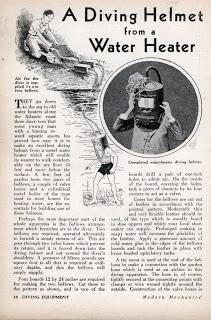
A Diving Helmet from a Water Heater
THEY go down to the sea in old water heaters along the Atlantic coast these days, now that some young man with a leaning toward aquatic sports has proved how easy it is to make an excellent diving helmet from a metal water heater which will enable its wearer to walk comfortably on the sea floor 35 feet and more below the surface. A few feet of garden hose, two pairs of bellows, a couple of valve boxes and a cylindrical metal boiler of the type used in most homes for heating water, are the essentials for building one of these helmets.
Perhaps the most important part of the whole apparatus is the bellows arrangement which furnishes air to the diver. Two bellows are required, operated alternately to furnish a steady stream of air. This air goes through two valve boxes which prevent its return, and it is forced down into the diving helmet and out around the diver’s shoulders. A pressure of fifteen pounds per square foot is all that is required at ordinary depths, and this the bellows will amply supply.
Four boards 12 by 24 inches are required for making the two bellows. Cut these to the pattern as shown, and in two of the boards drill a pair of one-inch holes to admit air. On the inside of the board, covering the holes, tack a piece of chamois by its four corners to act as a valve.
Gores for the bellows are cut out of leather in accordance with the printed pattern. Moderately thin and very flexible leather should be used, of the type which is usually found in shoe uppers and which your local shoemaker can supply. Prolonged soaking in soapy water will increase the pliability of the leather. Apply a generous amount of cold water glue to the edges of the bellows boards and tack the leather in place with brass headed upholstery tacks.
A tin snout is used at the end of the bellows to make a connection with the garden hose which is used as an airline in this diving apparatus. The hose is, of course, tightly secured at the connecting points with clamps or wire wound tightly around the outside. Construction of the valve boxes is simple and is clearly shown in the drawing.
Two are used, one for each line from the twin bellows. They are merely check valves to make sure that the air flows in one direction only, towards the helmet. White pine is used in their construction and the boxes are well varnished when completed. The valve used is of light chamois with a small oak counterweight tacked or glued to it to assure rapid closing of the valve.
The fittings used to connect the valves and the helmet with the hose line are ordinary marine water intakes which you can obtain at any hardware store, at a cost of about eighty cents apiece. Use white lead in the holes and apply rubber gaskets under the fittings. Three feet is the proper distance between the valve boxes and bellows; the distance between valve boxes and helmet can be varied to suit.
Next comes the helmet itself. Mark off the openings to be cut for the diver’s shoulders, being sure to leave ample space for the head. Suggested proportions are shown in the drawing. Cutting is done with a cold chisel or a welding flame. For padding around the edges where the helmet fits over the shoulders three or four layers of an old inner tube are used, folded and riveted into place
A piece of cylindrical glass of the same curvature as the boiler is inserted in the front of the helmet for a window.
This glass can be purchased for about two dollars from the nearest wholesale glass jobber, who can be reached through your local hardware merchant. A flange of 16-gauge cold-rolled sheet steel is used to back up the glass. Smooth-on iron cement which, when set, is watertight and strong, is used to hold the glass in place. In operation the helmet will prove buoyant, and to counteract this a set of lead weights should be attached. Twelve pounds will be sufficient in most cases.
Two men are necessary in using the diving apparatus, one as the diver, the other to operate the bellows, which are pumped alternately. The idea is to keep a steady pulsation of bubbles coming to the surface from the diver. He absorbs some of the air in the helmet when he breathes, which is replaced with fresh air, and when he exhales the surplus is forced out under the helmet and finds its way to the surface.
Should a break occur in the air line the diver is in no danger, for he can readily slip off the helmet over his head and swim to the surface unhampered. The depth at which this apparatus is workable is determined as the point where the pressure of the air supplied by the bellows is equal to that of the water. Depths of 20 feet are easily attained, and for making repairs on boat hulls, recovering sunken parts or for studying lake bottoms this is usually quite as far as one cares to descend.
Thanks to Modern Mechanix
Kathy Dowsett
www.kirkscubagear.com